#Dressing, #style, #fashion
How can semiotic analysis help fashion business? Semiotics is the study of meaning of things. Fashion is mean of communication.
The difference between “clothing” and “fashion” is that clothing serve the purpose of protecting ourselves from the weather, while fashion serves the purpose of making people fit for their “social environment”. Every social group has its own rules which entail also how you dress. You maybe required to feature an elegant dress code for an cocktail party or you maybe required to wear an understated suit for for work.
Your ability to wear appropriate clothes communicate to other people that you are fit for the social group you want to belong to.
The same logic can be applied to the analysis of marketing communications such as advertising, brand signs, packaging, social media communication, corporate facilities and every other element of the brand image.
“It is only shallow people who do not judge by appearances. The true mystery of the world is the visible, not the invisible….”
Oscar Wilde, The Picture of Dorian Gray
Fashion Trends: the semiotic perspective
In this article we explain the fashion trends from a Semiotics perspective.
In order to be successful in the fashion business you need to understand the difference between macro-trends and micro-trends.
It’s easy to explain: Macro-trends are long term habits that people will keep having for a long period of time, you should meet the needs of this long term trends with the core product offer of your brand. While micro-trends are short terms hypes that can generate high volumes of sales for a brief period of time but they are destined to deflate.
An example of macro-trend is the casualization of business dress codes. This is a macro trend started in the 1970s with casual Fridays, then in the new economy era, casual wear became the standard dress code for digital and ecommerce professionals. Now casual wear is developing further with the increase of home working. This macro trend is generating new hybrid segments such as Athleisure and Leisurewear or clothing that you can were at home and outside. Check out this article on Bobbyberk.com.
In the Semiotic square of fashion, that you see here below, you find the semiotic value “IN” (Cool) at the top left of the quadrant and the value “OUT” (Passé) at the top right of the quadrant.
These two positions, top left and top right, represent conflicting values in the semiotic quadrant.
At the left we have the semantic area of “in trend“, that includes the dresses and styles that are considered cool in the present moment.
At the top right corner we have the “outdated” trends, styles and clothing that were once in but now have lost their appeal. For example, let’s think of the ‘very low raise jeans‘ that were popular at up until 2005, if you wear them today (2021) you would be considered out of trends. However they are coming back, see the Google Trends chart at the bottom of this page for the updated trend.
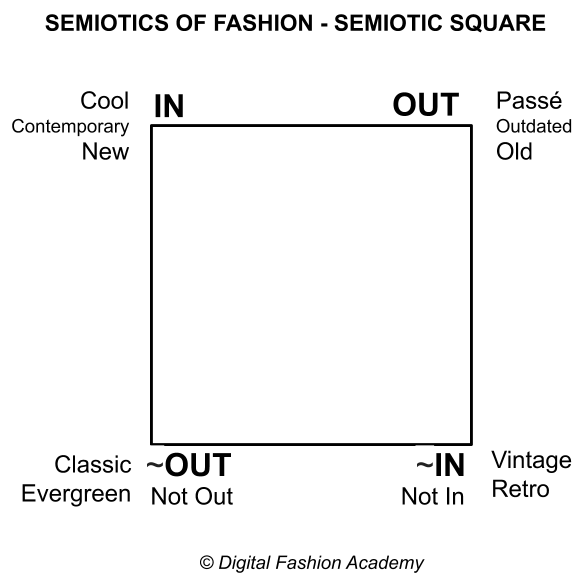
The semiotic perspective describes the positive and negative values of fashion. What’s in trend has a positive fashion value, what’s not in trend has a negative fashion value
What is semiotics of fashion?
Semiotics of fashion is the analysis of the meaning of signs applied to the fashion industry with the purpose of understanding the implicit meaning of clothing, design and symbols. It can be applied to clothing as well as brands and other forms of fashion communication like web communication, influencers collaborations, advertising campaigns and every other communicative aspect of a fashion brand. (c) Digital Fashion Academy
Why is semiotics of fashion important?
The semiotics analysis is an inexpensive tool that anyone with the right competence can apply to any aspect of fashion communication to determine what is the message that the brand is getting across and whether or not the message is consistent with the goal of the brand. Marketing managers in fashion companies will define the messages and media (from medium latin = mean of communication) through which the brand communicates with prospects and customers. This messages are part of the digital marketing plan.
How to apply semiotics of fashion to digital marketing?
The semiotics analysis can be applied to web pages as well as digital campaign. The semiotic analysis can be used to is to establish the consistency of the message, the consistency of the brand dna and in general in alla fashion marketing activities to check the coherence of the content, graphic designs and other communication:
- Is the message consistent with the goal? Is there an action that we want the reader to take? Is there a secondary message? Is the message clearly readable on all devices?
- Is the message internally consistent? Is there a visual consistency? To determine the consistency of the message you need to find the isotopy, which is the “fil rouge” or thread, and verify its consistent presence throughout the message. This is an essential part of story telling as we can read in the paragraph below from Wikipedia.
In a story, we detect an isotopy when there is a repetition of a basic meaning trait (seme); such repetition, establishing some level of familiarity within the story, allows for a uniform reading/interpretation of it. An example of a sentence containing an isotopy is I drink some water.
Wikipedia
What is the meaning of clothes?
The history of fashion goes back a long time. The meaning of clothes has changed during the centuries, from pure representation of status to expression of self #secondskin.
However the fundamental meaning behind the style we adopt have remained unchanged and as of today it can be traced back to one single word “belonging“.
Whether you are a teenager, a rich entrepreneur, a fashionista, an engineer or else, what you want from your dress is to make you acceptable among your peers.
In other words we can say that what makes you accepted by your group of reference is IN and what makes you not acceptable is OUT.
The other variable in this scenario is time.
As technology, climate, cultural and political situation changes, fashion design and taste changes accordingly and consequently. Therefore what was IN six months ago will probably be OUT in twelve months.
At the same time there will be some classic pieces that will never go out of fashion, although I would say this is pretty rare. More likely some clothes in your wardrobe will go out-of-fashion and then come back IN and if you are lucky you will be able to wear them again.
In the diagram below, the fashion lifecycle is explained with the aid of a semiotic square in which the horizontal elements are opposites (or contrary), the vertical elements are complementary and diagonal elements are contradictory.
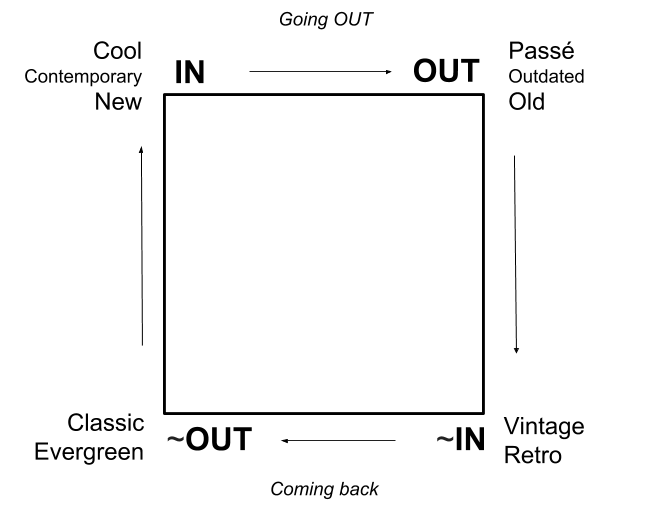
Fashion is the eternal return of the new
Walter Benjamin
Another use of the Semiotic Quadrant is to analyse the motivation behind choices of fashion. In the below quadrant we analyse the different use of fashion from protection from cold and weather to self expression.
What are fashion values?
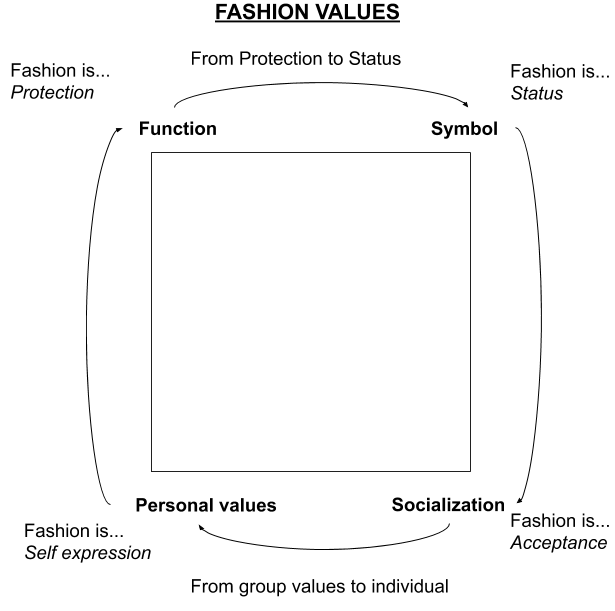
Fashion is by definition something that changes with time. Therefore the styles that have a positive value today will have a negative value tomorrow.
This fact has some important impacts on society:
- Creates the need to buy new clothes;
- It generates is less stability;
- Allows people to decide whether they want to follow fashion or not;
The trickle down effect
Fashion can be partly explained as the development of a new trend from a small group of people who adopt it (early adopters) to a vast population who follow the trend and purchase a style once it is well consolidated.
Decades and centuries ago when the only people who could afford to adopt new trendy clothing styles were the upper class people, this effect was called “trickle down” to describe the fact that the trends were initially adopted by the higher classes and then later on by the general population.
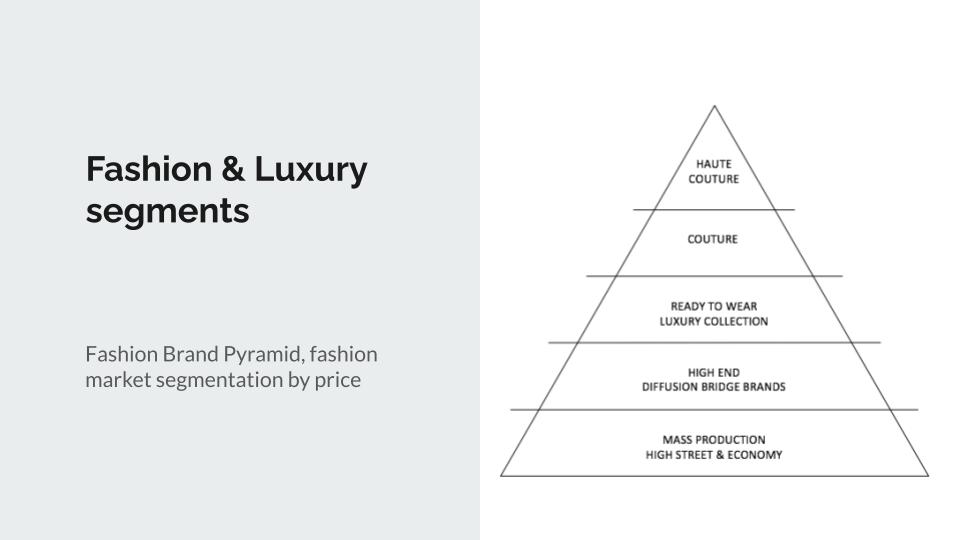
Dresses semiotic quadrant
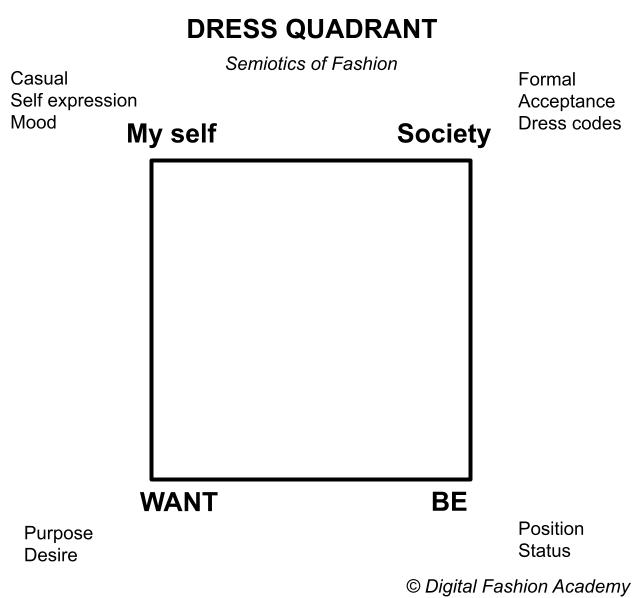
There is always an aspect of compliancy when we decide which clothes to wear. It could be compliance with work reltaed rules or social group. The choice of what to wear is always tied to be accepted in our social group.
The chart below shows the trend of keywords searches on Google for “low rise jeans” and “high rise jeans”. You can see that the “low rise jeans” blue line went “out of fashion” at the end of 2005, but they are now coming back. While “high raise jeans” are a complete new trend, it seems like they didn’t existed before.

File:Mannequin with jeans.jpg
Created: 31 March 2009
Fashion semiotics and politics: fashion to represent a political group
We can trace the first use of clothing as political mean of communication in the revolutionary France. At that time aristocracy use to were short-to-the-knee breeches (a.k.a. Coulottes) while the poor people of the working class used to were long trousers.

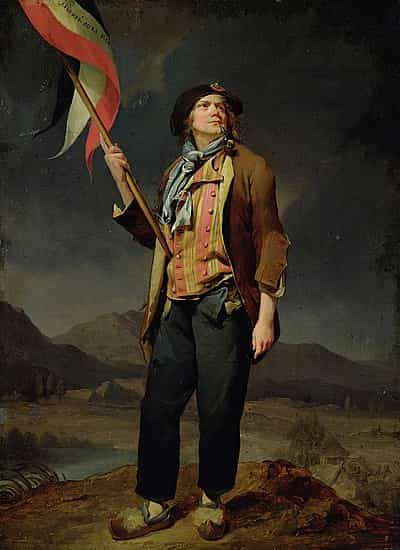
मुझे कपड़ों के बारे में बताने के लिए धन्यवाद मैं कपड़ों के बारे में इतना नहीं जानता था